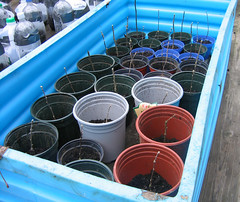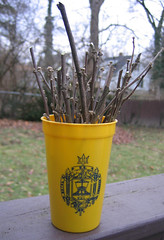ROS Cuttings
First of all, I apologize for the dearth of posts. I don’t usually make excuses for, or even comment on, my absences, but in this case I want to share good news. I’m changing jobs (for the better) and the transition is keeping me busier, happier, and more fulfilled than usual. As spring approaches, though, it’s time to return my focus to the important things in life – like gardening!
 I’ve been teasing you since last month on my mysterious use of the ghetto cold frame. As you can see in the photo, it is now filled with hardwood cuttings from the Rose of Sharon I discovered in the North Corner last summer. The 30 cuttings, once rooted, will be planted to form a semicircular hedge and create a garden room of the once hated North Corner.
I’ve been teasing you since last month on my mysterious use of the ghetto cold frame. As you can see in the photo, it is now filled with hardwood cuttings from the Rose of Sharon I discovered in the North Corner last summer. The 30 cuttings, once rooted, will be planted to form a semicircular hedge and create a garden room of the once hated North Corner.
As I transitioned from the military to the softer, gentler, more politically correct world of business I had to learn a whole new vocabulary. One of the ickiest terms I’ve had to endure is “opportunity area” (meaning “weakness”). As much as the euphemism makes me want to puke, I’ve taken the same sort of Pollyanna attitude towards the North Corner. I plan on transforming the ugliest corner of the yard into a charming garden room. The ROS hedges will be the “walls” and I am building an arbor for the “door.” Opportunity awaits!
 I’ve never done hardwood cuttings, or cuttings at all, before this attempt. According to the sources I’ve read, hardwood cuttings are best done in the winter, when the plant is dormant and leafless, so that the cutting does not desiccate through the leaf surface and puts energy into making roots instead of top growth. The cuttings should be between 6 and 9 inches long and have a few leaf nodes. The top of the cutting should be just above a node and the bottom (root end) should be just below a node. I was unsure whether older or younger branches would be better suited for cuttings, so I used wood from both last summer and the previous year.
I’ve never done hardwood cuttings, or cuttings at all, before this attempt. According to the sources I’ve read, hardwood cuttings are best done in the winter, when the plant is dormant and leafless, so that the cutting does not desiccate through the leaf surface and puts energy into making roots instead of top growth. The cuttings should be between 6 and 9 inches long and have a few leaf nodes. The top of the cutting should be just above a node and the bottom (root end) should be just below a node. I was unsure whether older or younger branches would be better suited for cuttings, so I used wood from both last summer and the previous year.
ROS is supposed to be one of the easiest shrubs to root from cuttings, but I used hormone powder, just to be safe. After dipping each cutting in the hormone powder, I inserted them into pots of soil. I put the pots in a cold frame to give the cuttings protection from the wind and frost. I do not want the sticks to break dormancy until some roots have developed, so there is no need to put the cuttings in a heated area. Thus, the cold frame is an ideal environment.
I have no idea if this will work. In preparation for this project, I read a number of strange methods of rooting cuttings, including bundling the sticks and burying them completely, UPSIDE DOWN. (I’d love to hear details on anyone else’s experience with the “buried alive and upside down” method.) The approach I chose seemed to be the simplest and most likely to work. If my experiment fails, Roses of Sharon are pretty inexpensive shrubs. However, a free hedge is best of all.
 I’ve been teasing you since last month on my mysterious use of the ghetto cold frame. As you can see in the photo, it is now filled with hardwood cuttings from the Rose of Sharon I discovered in the North Corner last summer. The 30 cuttings, once rooted, will be planted to form a semicircular hedge and create a garden room of the once hated North Corner.
I’ve been teasing you since last month on my mysterious use of the ghetto cold frame. As you can see in the photo, it is now filled with hardwood cuttings from the Rose of Sharon I discovered in the North Corner last summer. The 30 cuttings, once rooted, will be planted to form a semicircular hedge and create a garden room of the once hated North Corner.As I transitioned from the military to the softer, gentler, more politically correct world of business I had to learn a whole new vocabulary. One of the ickiest terms I’ve had to endure is “opportunity area” (meaning “weakness”). As much as the euphemism makes me want to puke, I’ve taken the same sort of Pollyanna attitude towards the North Corner. I plan on transforming the ugliest corner of the yard into a charming garden room. The ROS hedges will be the “walls” and I am building an arbor for the “door.” Opportunity awaits!
 I’ve never done hardwood cuttings, or cuttings at all, before this attempt. According to the sources I’ve read, hardwood cuttings are best done in the winter, when the plant is dormant and leafless, so that the cutting does not desiccate through the leaf surface and puts energy into making roots instead of top growth. The cuttings should be between 6 and 9 inches long and have a few leaf nodes. The top of the cutting should be just above a node and the bottom (root end) should be just below a node. I was unsure whether older or younger branches would be better suited for cuttings, so I used wood from both last summer and the previous year.
I’ve never done hardwood cuttings, or cuttings at all, before this attempt. According to the sources I’ve read, hardwood cuttings are best done in the winter, when the plant is dormant and leafless, so that the cutting does not desiccate through the leaf surface and puts energy into making roots instead of top growth. The cuttings should be between 6 and 9 inches long and have a few leaf nodes. The top of the cutting should be just above a node and the bottom (root end) should be just below a node. I was unsure whether older or younger branches would be better suited for cuttings, so I used wood from both last summer and the previous year.ROS is supposed to be one of the easiest shrubs to root from cuttings, but I used hormone powder, just to be safe. After dipping each cutting in the hormone powder, I inserted them into pots of soil. I put the pots in a cold frame to give the cuttings protection from the wind and frost. I do not want the sticks to break dormancy until some roots have developed, so there is no need to put the cuttings in a heated area. Thus, the cold frame is an ideal environment.
I have no idea if this will work. In preparation for this project, I read a number of strange methods of rooting cuttings, including bundling the sticks and burying them completely, UPSIDE DOWN. (I’d love to hear details on anyone else’s experience with the “buried alive and upside down” method.) The approach I chose seemed to be the simplest and most likely to work. If my experiment fails, Roses of Sharon are pretty inexpensive shrubs. However, a free hedge is best of all.


5 Comments:
I have a billion ROS seedlings all _over_ my yard. I'm sure you'll have no problem propagating that persistent thing.
Hah! I was right! You're not using your coldframe for the usual stuff. I knew that you would come up with something unique. I can't wait to see how this turns out.
that sounds pretty darn cool. I'm inspired to do more in the garden after reading your blog entries..but sadly I think I just maybe inspired this year...that and pooped.
If it doesn't work, you're welcome to take a trip out to my house and dig up some seedlings--I have plenty!
Aren't coldframes great? I am starting some seedlings in one half of mine and trying to grow some salad greens in the other. Just this weekend I renovated my blueberries and am trying several different methods to get some cuttings to root.
Post a Comment
<< Home